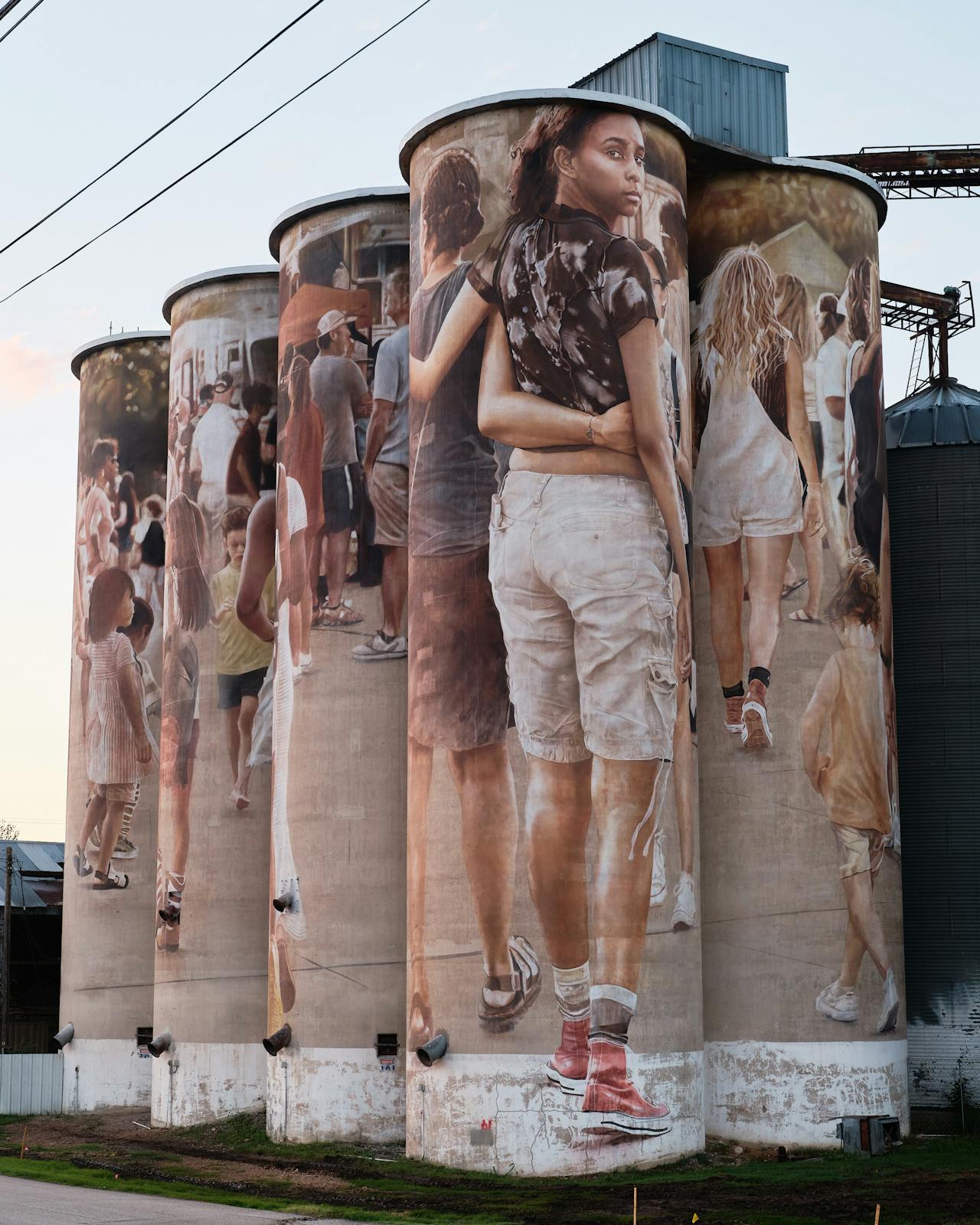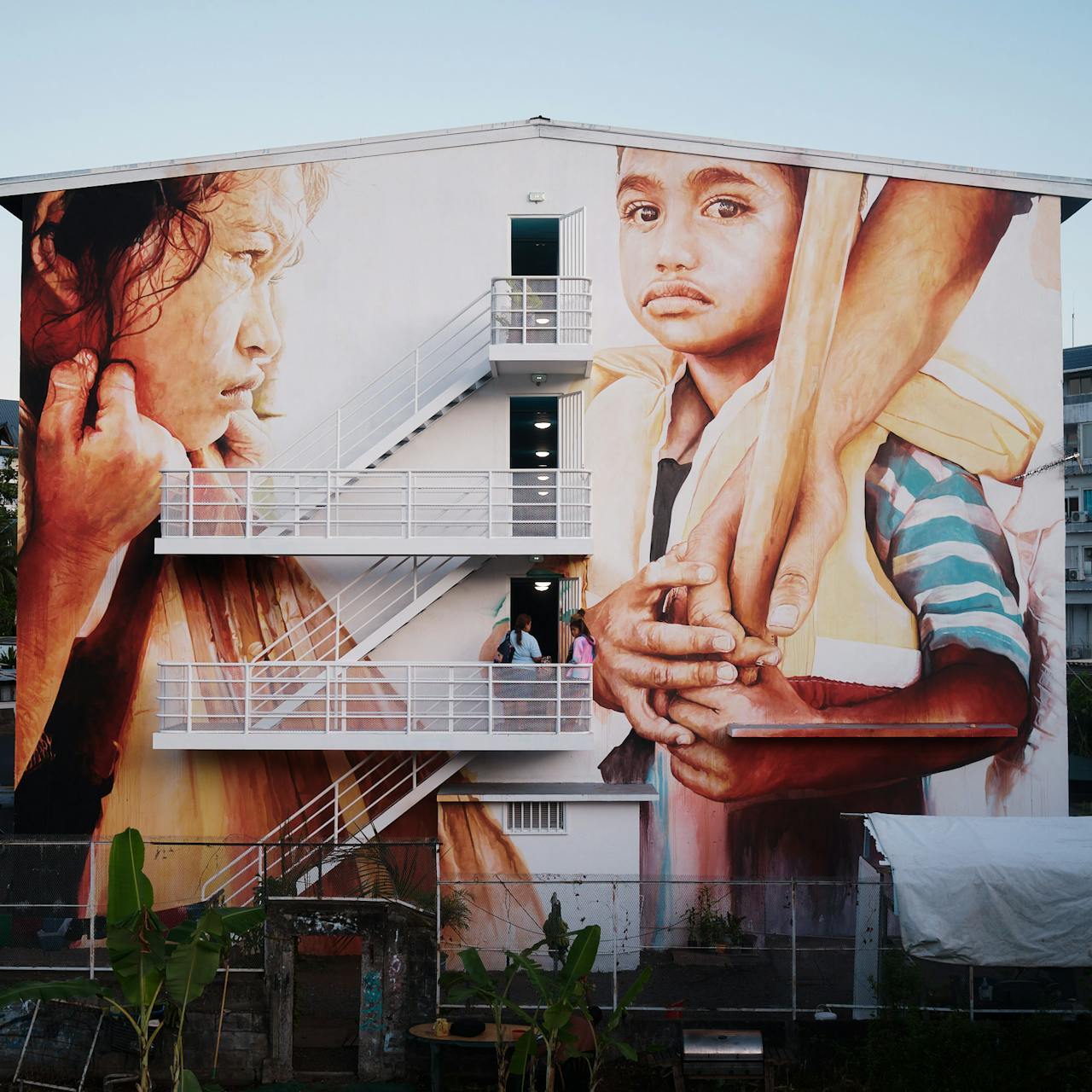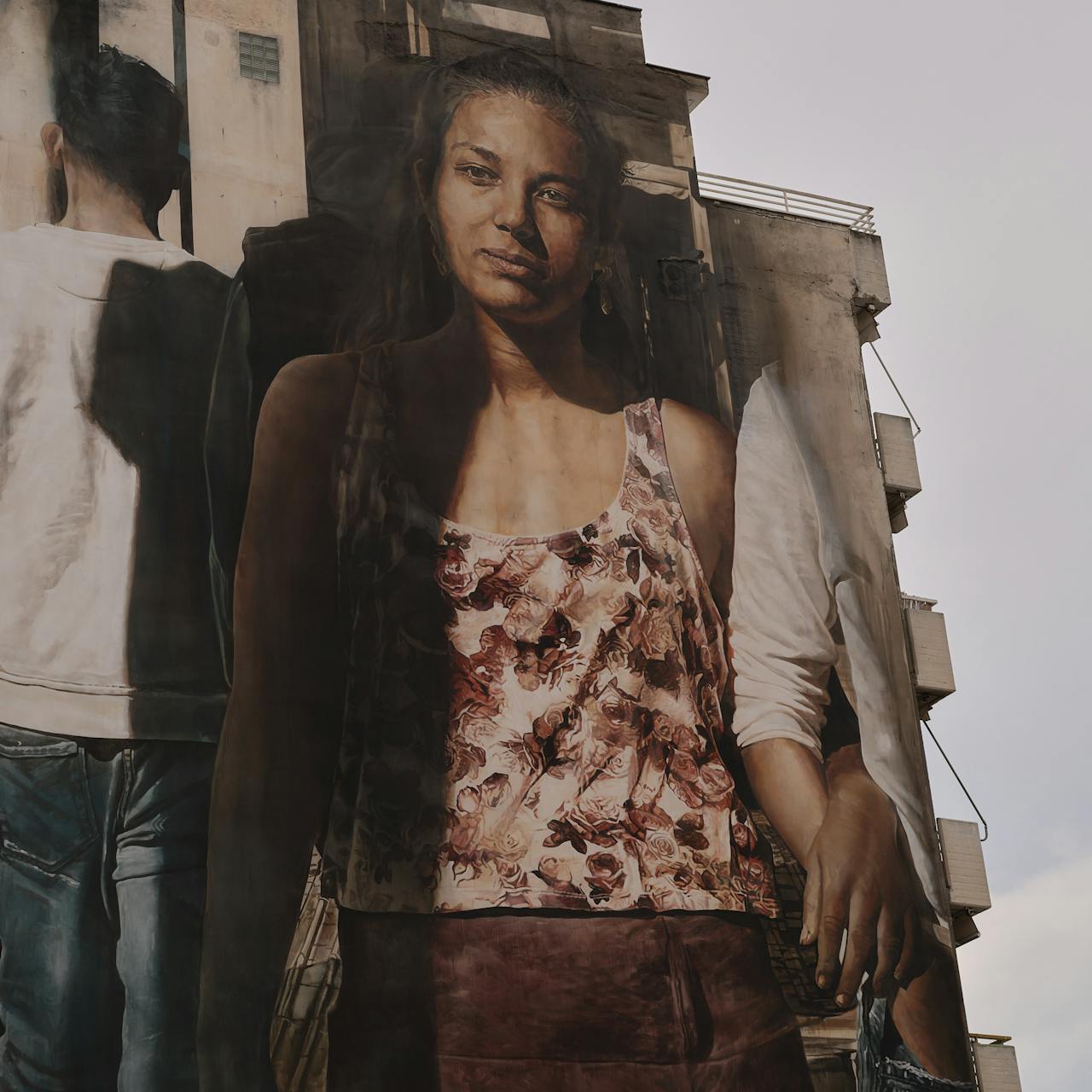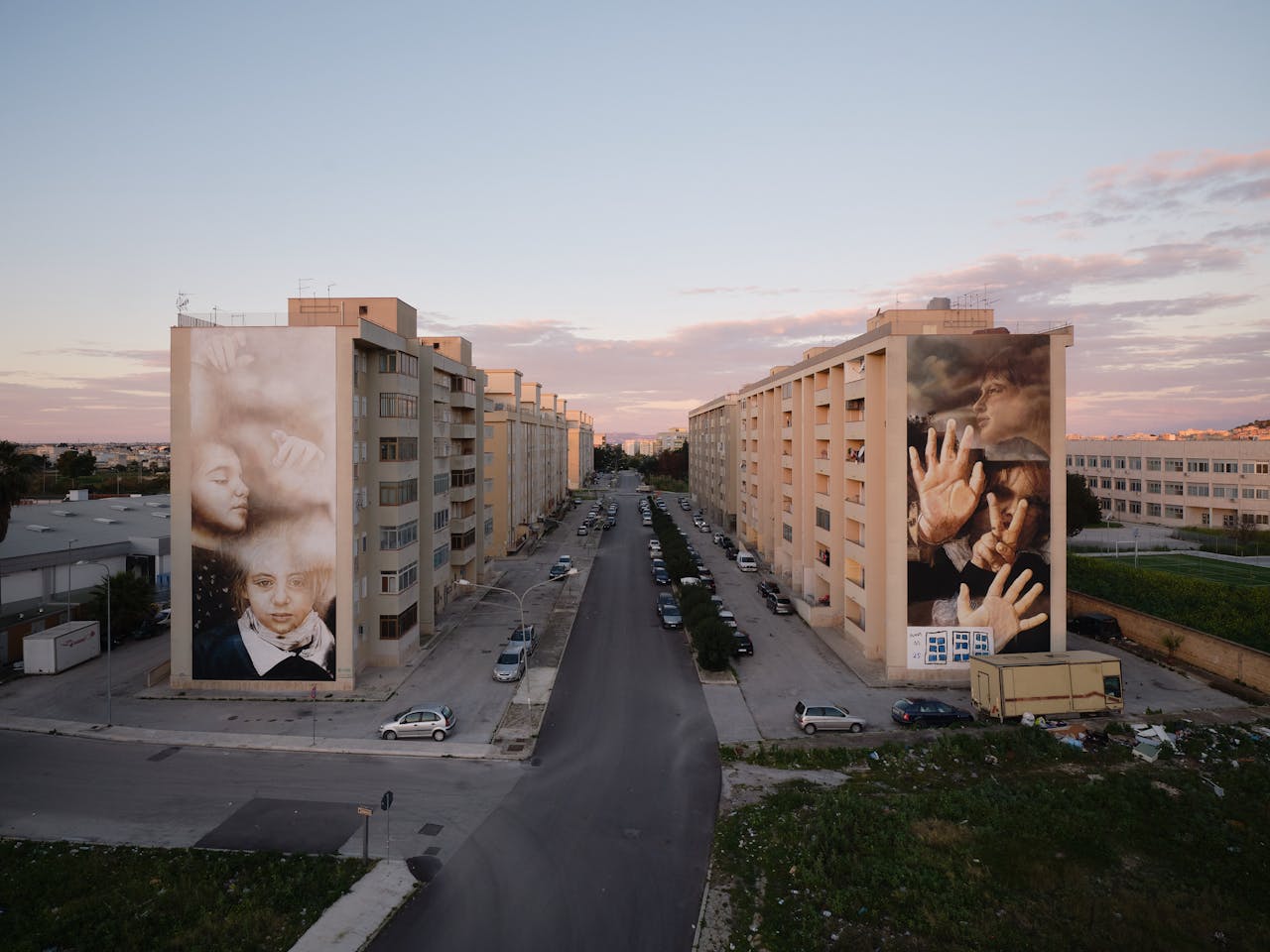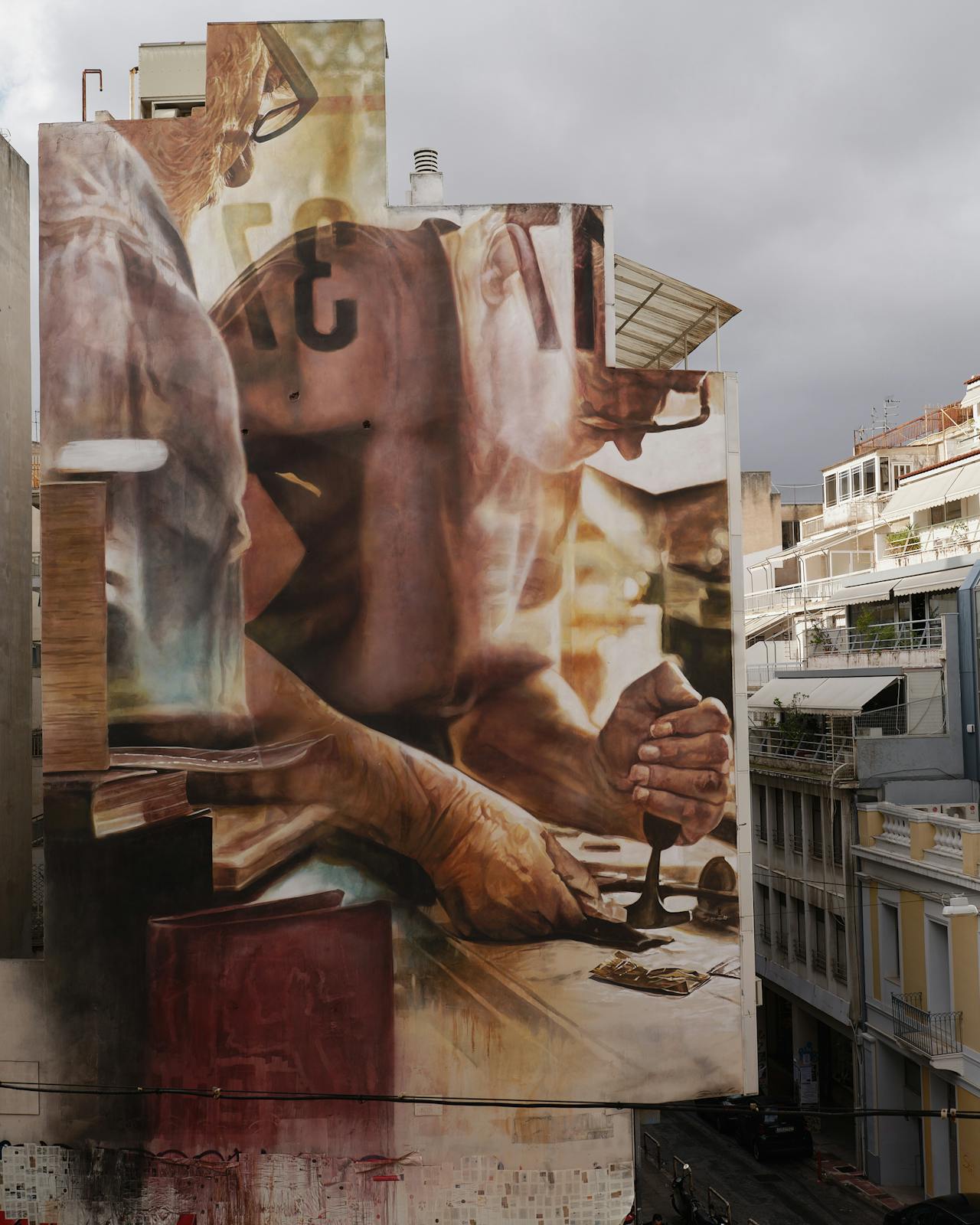Monuments Project - Minnesota
Mankato, Minnesota,
2020
Completed mural, Mankato, Minnesota. June 2020 Photograph: Guido van Helten
Minnesota’s largest mural, this artwork is installed at the Ardent Mills grain silos – positioned at the gateway of Mankato’s Old Town and seen from several vantage points across the Minnesota River.
A city of approximately 40,000 people, Mankato is situated on Dakota lands ceded to the United States government in the 1851 Traverse des Sioux Treaty. The location of the mills is also significant due to their proximity to Reconciliation Park – the site of the largest mass execution in U.S. history, the hanging of thirty-eight Dakota men following the 1862 U.S.-Dakota War.
The concept is inspired by Guido van Helten’s experiences and observations at Mankato’s annual Mahkato Wacipi, a traditional powwow held every year at Dakota Wokisuye Makoce (Land of Memories Park). Intended as a gathering of nations to honour Dakota culture, the powwow is an important healing and reconciliation effort that acknowledges the ramifications of the 1862 war while working towards building a new, shared local history.
Photographs by Sara Hughes and Guido van Helten
Project Details
Project
Monuments Project - MinnesotaLocation
Mankato, MinnesotaCommissioner
CityArt – coalition between Twin Rivers Council for the Arts and City Center PartnershipEducation Day at Mahkato Wacipi, Mankato, Minnesota. September 2019 Photograph: Guido van Helten
Part of van Helten’s developing Monuments series repurposing agricultural landmarks throughout the U.S. South and Midwest, the artwork reflects the city of Mankato's commitment to acknowledgement and reconciliation of the past, shared cultural practices, and community diversity — in particular, through education.
Following lengthy consultation with local community leaders, Van Helten was particularly inspired by the Mahkato Wacipi’s Education Day cultural exchange program, through which local elementary school children learn about and experience Minnesota history and heritage from Mdewakanton Dakota and other Native American peoples. At the end of the day’s activities, the children participate in a circle or ‘friendship’ dance. Van Helten worked with Mankato photographer Sara Hughes to document the dance at the 2019 powwow, informing his final design of a young Dakota girl leading a procession of children of various ages and ethnicities.
Education Day at Mahkato Wacipi, Mankato, Minnesota. September 2019 Photograph: Guido van Helten
Dave Braveheart introduces the Education Day Program at Mahkato Wacipi, Mankato, Minnesota. September 2019 Photograph: Guido van Helten
Education Day at Mahkato Wacipi, Mankato, Minnesota. September 2019 Photograph: Guido van Helten
Guido van Helten, as told to John Reinan, Minnesota Star Tribune (June 2020), Mankato’s massive silo mural is finished and ‘really inspiring people to think big’
[That] was a touching moment… That was a perfect link to say, ‘This is a community coming together.'3
Traditional dance, Mankato, Minnesota. September 2019 Photograph: Guido van Helten
Justin Perkins, In These Times (January 2018), The 38 Dakota Warriors Lincoln Hanged. Sometimes the ‘Dakota 38’ are referred to as ‘Dakota 38+2,’ recognising the warriors executed in 1862 as well as Sakpedan (Little Six) and Wakan Ozanzan (Medicine Bottle), two Dakota leaders who were executed at Fort Snelling in 1865.
Held annually since 1972, the Mahkato Wacipi began as a way to honour the losses and impacts of the U.S.-Dakota War, which resulted in the execution of thirty-eight Dakota warriors (known as the ‘Dakota 38’4) and the mass expulsion of the Dakota people from their lands in Minnesota.
The powwow was initiated through the friendship of two men from different backgrounds: Amos Owen, a Dakota elder and spiritual advisor from the Prairie Island Mdewakanton Community (90 miles northeast of Mankato) and Bud Lawrence, a non-Dakota businessman from Mankato. They met by chance while fishing on the Minnesota River and their conversations over the years evolved into a dialogue about reconciliation in Mankato, which led to the suggestion of holding a powwow in the town. An informal gathering was held at a baseball field in 1965, but with the support of the city in 1972 the powwow was established as a yearly event.
Honouring the first Mahkato Wacipi and its founders, Mankato, Minnesota. June 2020 Photograph: Guido van Helten
For van Helten, it was enlightening to learn that the powwow has foundations built on the cooperative efforts towards reconciliation from both Dakota and non-Dakota people. The collaboration between two friends and the shared history they created through mutual respect and cooperation was an important symbolic foundation for the artist’s own project.
Traditional dance and audience, Mankato, Minnesota. September 2019 Photograph: Guido van Helten
Mary Wingerd (2010), North Country: The Making of Minnesota
American Indian Quarterly (2004), Ties That Bind
Valerie DeCora Guimaraes, Mankato Free Press (September 2016), Woman recalls first Mankato powwow
John Biewen, This American Life (November 23, 2012), Little War on the Prairie
In These Times (January 2018), The 38 Dakota Warriors Lincoln Hanged
Changing community attitudes and awareness of the Native American history of Minnesota can be seen in the ways in which the 1862 conflict and execution have been memorialised over the years. As historian Mary Wingerd argues, for much of the twentieth century, myth rather than history shaped what most Minnesotans knew about the Dakota people.5 The war was largely brushed over and forgotten – or mischaracterised as an unprovoked attack against innocent white settlers by the Dakota. In history books the war was recorded as a ‘rebellion,’ ‘outbreak’ or ‘the ‘Great Sioux Uprising,’ obscuring the actions of the settlers and government during the six weeks of fighting. Scant attention was paid to the context for the conflict: the colonialist policies that sought to remove Dakota people from their homelands, and how the inequitable treaties deprived them of a sustainable livelihood.6 At the site of the mass execution, the only public acknowledgement was a brusque marker erected in 1912 reading: ‘Here were hanged Thirty-Eight Sioux Indians, Dec. 26, 1862.’7 Even among the Dakota diaspora, knowledge of the events was limited; for others, Mankato had a reputation as an unwelcoming place for indigenous peoples, haunted by its dark past.8
Reconciliation and education efforts such as the powwow and Education Day, the Dakota 38 Memorial ride/run9, and the renaming of the site of the hangings as Reconciliation Park have helped facilitate an honest reckoning with the history of Native and non-Native relations in Minnesota, and encouraged understanding of the profound impacts of the U.S.-Dakota War.
Honoring the anniversary of the 'Dakota 38+2', Mankato, Minnesota. December 2019 Photograph: Sara Hughes
This American Life (November 23, 2012), Little War on the Prairie
The Dakota have lived in Minnesota for thousands of years and vastly outnumbered Europeans until the mid-1800s, when white traders and farmers began settling in Dakota territory. As happened across the country, the indigenous peoples came to be perceived as an obdurate presence forestalling settler expansion and progress, leading to mutual suspicion and tension between some communities.
In the interests of obtaining valuable land, the government enacted a series of policies that would define Native and non-Native relations for the decades leading up to the U.S.-Dakota conflict. The Indian Removal Act of 1831 compelled indigenous groups to relocate to ‘Indian Territory’ and away from settler townships – leading to an increasing reliance of the Dakota on goods obtained from white traders. This also led to a growing amount of debt, effectively forcing the Dakota to negotiate the series of treaties that ceded their land to the United States.10
Mahkato Wacipi, Mankato, Minnesota. September 2019 Photograph: Guido van Helten
Mahkato Wacipi, Mankato, Minnesota. September 2019 Photograph: Guido van Helten
Mahkato Wacipi, Mankato, Minnesota. September 2019 Photograph: Guido van Helten
Mahkato Wacipi, Mankato, Minnesota. September 2019 Photograph: Guido van Helten
Ibid.
David Martínez, Wicazo Sa Review (2013), Remembering the Thirty-Eight: Abraham Lincoln, the Dakota, and the U.S. War on Barbarism
This American Life (November 23, 2012), Little War on the Prairie
Carol Chomsky, Stanford Law Review (1990): The United States-Dakota War Trials: A Study in Military Injustice
This American Life (November 23, 2012), Little War on the Prairie
Stanford Law Review (1990): The United States-Dakota War Trials
Wicazo Sa Review (2013), Remembering the Thirty-Eight
Stanford Law Review (1990): The United States-Dakota War Trials
In the decade between the signing of the treaties and the 1862 war, the white population of Minnesota had exploded from 5,000 to more than 170,000.11 The Dakota people occupied only a narrow reservation along the Minnesota River, and found they could no longer support themselves through traditional means. Moreover, the arrangements for cash and food annuities and access to natural resources laid out in the treaties were not always being honored.12 In the summer of 1862, the Dakota desperately awaited their annual payments and promised provisions. The previous year had been a bad crop year, and many families faced starvation. But as a result of the Civil War raging throughout the surrounding states, federal shipments owed to the Dakota were delayed, and many white traders refused to provide food and supplies on credit.13
In August 1862, the tensions between the Dakota and settler communities boiled over when a small hunting party of Dakota men killed five white settlers near Acton Township. Anticipating retaliation, the men consulted their leaders. The Dakota people were not unanimous in the desire for war but for a small faction the conflict was justified – a rightful demand for a return to their traditional way of life.
This faction organised assaults on federal outposts at Fort Ridgeley and New Ulm, and on some settlers’ homesteads. Though no one knew with certainty how many lives had been lost, it is estimated that in the thirty-seven days of fighting, seventy-seven American soldiers, twenty-nine citizen-soldiers, approximately three hundred and fifty eight settlers, and an estimated twenty-nine Dakota warriors were killed.14
The conflict culminated in the capture and imprisonment of almost four hundred Dakota men by the U.S. Army. Meanwhile, upon the word of former Minnesota governor and colonel of the state militia Henry Sibley that only those who had murdered settlers would be punished, hundreds of Dakota civilians had also surrendered themselves to American soldiers. Instead, they were marched down Minnesota River, through vengeful settler townships, and interned at Fort Snelling for over a year – during which many of the most vulnerable perished.15
The captured Dakota warriors were tried – not before a criminal court but before a military commission – and 303 of them were convicted for alleged ‘murders or other outrages upon the Whites’ and condemned to die.16 President Abraham Lincoln was called upon to review the trials and, despite mounting pressure from the enraged Minnesota population, reduced the number of condemned to thirty-nine (with the thirty-ninth acquitted at the last moment). For some, Lincoln ‘sparing’ over two hundred lives is evidence of his magnanimity, while others believe the President made a shrewd compromise in order to appease the Minnesota populace threatening mob violence against the prisoners.17 Applying criminal sanctions to punish those defeated in war was an action without precedence, even in previous conflicts between Native American nations and settlers.18
Dakota 38+2 Memorial riders, Mankato, Minnesota. December 2019 Photograph: Sara Hughes
Gathering at Reconciliation Park, located at the base of Ardent Mills, Mankato, Minnesota. December 2019 Photograph: Sara Hughes
An Act for the Removal of the Sisseton, Wahpaton, Medawakanton, and Wahpakoota [Wahpekute] Bands of Sioux or Dakota Indians, and for the Disposition of their Lands in Minnesota and Dakota, 12 Stat. 819 (1863).
Roy W. Meyer (1993), History of the Santee Sioux: United States Indian Policy on Trial
Wicazo Sa Review (2013), Remembering the Thirty-Eight
Citing continued ‘hostility’ between the communities and fearing further rebellion, the government felt justified in enacting a statute for removing all members of the four bands of Dakota from Minnesota territory and confiscating all of their treaty lands.19 Even those who had opposed the war, or remained neutral were removed – the first time the United States had chosen to remove Native Americans by statute, without an agreement by treaty.20 As legal scholar Carol Chomsky and others have argued, the Dakota war trials were a miscarriage of justice, the treatment of the prisoners of war was inhumane, and the subsequent forced expulsion of all Dakotas out of Minnesota was an especially brutal act of retribution.21
For Native and non-Native peoples alike the conflict was deeply felt, fracturing the hesitant but often cooperative relations between the communities – and profoundly shaping the state of Minnesota and the stories it told about its origins for decades to come.
Artist at work in winter, Mankato, Minnesota. November 2019 Photograph: Sara Hughes
Harvest moon, Mankato, Minnesota. November 2019 Photograph: Sara Hughes
Remembering the past, Mankato, Minnesota. June 2020 Photograph: Sara Hughes
Interviews conducted by the artist on June 27 and 28, 2020. These conversations have been edited for length and clarity.
At the mural’s completion, Guido van Helten spoke with Dave Brave Heart and Megan L. Schnitker, organisers of the Mahkato Wacipi. Brave Heart is Chairperson for Mahkato Wacipi, and Schnitker is Vice Chair, educator and traditional indigenous herbalist.22
During these conversations – edited here for length and clarity – they discussed the ongoing reconciliatory work of reckoning with Mankato’s history and the importance of education and cross-cultural exchange. They also offered their interpretations of van Helten’s artwork and its value as a ‘monument’ to the increasing diversity in Mankato’s community.
Guido van Helten: Tell me about the powwow.
Megan L. Schnitker: The Mankato powwow has been going on for almost fifty years now. And, it's part of reconciliation because Mankato has such a terrible history, with the hanging that happened in 1862. Prior to that, our indigenous people were pushed out of this area for settlers, for farms, and we were placed on reservations. And so the powwow was basically started to help heal that wound that happened between indigenous and non-indigenous people. It was started by a small group [whose] goal was to bring the community back together for healing.
Dave Brave Heart: You know, I heard over the years, ‘Have you ever gone to drive through Mankato? Go through at night, or just go around it. Bad place.’ What happened here with the hanging. And yet every year Mankato has had a powwow here since 1972. Because they had the powwow here, I knew I wanted to be involved. The powwow was about reconciling – about bringing in the non-Natives and the Dakota community together to heal, and to find some kind of a common ground. To work together, to partner, maybe to collaborate, to acknowledge the history for what it was. Because, quite frankly, there was that cloud hanging over Mankato.
MS: There's still work that needs to be done as far as actual reconciliation. But the powwow has brought the community together for education, for a celebration, and for hope and for healing. That's the main goal of the powwow. It's been a huge part of this community every September. We come together and it's all nations that come, not just Dakota. . . . All tribes [are welcome to] come together, to feel comfortable being back in Mankato. Because we still have relatives of those that were hung that are still not comfortable in Mankato, but by doing this powwow every year and inviting everyone in, in a welcoming manner, it helps heal that wound just a little bit more with every year that comes.
Mahkato Wacipi, Mankato, Minnesota. September 2019 Photograph: Guido van Helten
Mahkato Wacipi, Mankato, Minnesota. September 2019 Photograph: Guido van Helten
Mahkato Wacipi, Mankato, Minnesota. September 2019 Photograph: Guido van Helten
Mahkato Wacipi, Mankato, Minnesota. September 2019 Photograph: Guido van Helten
Junior Princess crowned at Mahkato Wacipi, Mankato, Minnesota. September 2019 Photograph: Guido van Helten
GvH: Why is the powwow important to the city of Mankato? Because, just from my perspective when I came in, it's such an amazing cultural event. I see this as a really unique, amazing thing. So it was my focus [for the artwork], but why is it important for the city to get behind it?
DBH: Building a relationship with the city was the real key. That's an important part of the healing, the understanding. It's pretty amazing how much they've supported this powwow. They acknowledged the Indigenous People's Day – going forward every second, Monday of October, it is Indigenous People's Day here in Mankato. That was pretty significant. . . . I think it was all about a good faith effort towards building better understanding and reconciling what happened.
MS: It's incredibly important for the city to be involved because it really is educating the public and the smaller communities surrounding Mankato about indigenous culture. Trying to educate about the Dakota Wars, and the good and the bad of the history. And then it's not such an uncomfortable topic anymore. . . . It’s for everyone to attend, you know, to enjoy themselves. Because it's not just powwow dancing or Wacipi dancing, it's a celebration of [all] cultures... It’s a beautiful thing that we can have people that respect our culture and our spirituality, our way of life enough to want to be a part of it and learn about it. That’s the importance of Mankato being involved so that [everyone] can feel welcome.
The artist greets children at Education Day, Mankato, Minnesota. September 2019 Photograph: Sara Hughes
GvH: First time I met you, Megan, was at the Education Day last year, and I saw that you were teaching there. Why is it important to educate kids and [particularly] non-indigenous kids that are coming to the powwow about what you're doing?
MS: Well, everything that I teach comes from a cultural perspective. 200,000 years ago, we didn't have Walgreens, we didn't have Walmart to go get our medicine and our food. We had to know what was living next to us. And we followed the oak tree and we follow it because that's where the main source of our food was and our most powerful medicine. And so I teach that to the sixth graders because it's not taught in school.
I have made it my mission to teach the younger generations. I have a lot of work to do to make sure that schools have resources available to this history because our history is also American history and all history needs to be included, not just, you know, the predominant culture’s version of history. Everyone has a history and it needs to be told. And so that's basically why I do what I do – to teach the younger generation about us, to spark their interest.
Megan L. Schnitker teaching traditional uses for plants at Education Day, Mankato, Minnesota. September 2019 Photograph: Guido van Helten
GvH: How many kids have gone through that program now?
DBH: Last year was the biggest year ever. They had over seven hundred sixth grade students. All of a sudden the enrolment for sixth grade jumped [by] over a hundred in 2019.
Education Day, Mankato, Minnesota. September 2019 Photograph: Guido van Helten
Education Day, Mankato, Minnesota. September 2019 Photograph: Guido van Helten
GvH: I don't know anything about American schooling because I didn't go through it, but [do they not] really teach Native American history? Or they only teach it from their perspective, and this is why Education Day is such an opportunity?
MS: It's an opportunity to hear history from the people that have handed it down from generation to generation. . . . Because you know, we get a couple of paragraphs in public school history books, and that's about all we get. . . . My seven year old argued with her teacher about Columbus [who was] saying Columbus discovered America, and she got really upset and she said, 'No, my people were here first!'
And so it's something that needs to be taught because, you know, anytime something goes against the mainstream narrative, it's dismissed. But our history and our culture is thousands and thousands of years old. And science is just now catching up to what our teachings have taught us for thousands of years.
Education Day, Mankato, Minnesota. September 2019 Photograph: Guido van Helten
We need to keep teaching the younger generation to be the next generation of voices to speak up.
GvH: And why is education important for reconciliation?
MS: We need it to be taught in schools. You know, it's not just about my kids and our culture. Mankato is a pretty diverse community. And I know nothing about my Somalian neighbors, I know nothing about my Muslim neighbors . . . Somalians and Muslims are recent immigrants, but they have a culture and they have a way of life, too, that needs to be taught. Education is so important because if, if you're not educated, you're ignorant. And if you choose to be educated, then you can learn and you can grow as a person…
DBH: I think education is the key to better understanding. And of course you have to have an open mind, you know. The way that you present things, that's an invitation to learning versus competition. Education is the key to change knowledge – you change the attitudes, [you] change behavior towards different populations. So it's really key.
Education is the key to change knowledge – you change the attitudes, [you] change behavior towards different populations.
Painting begins in winter, Mankato, Minnesota. December 2019 Photograph: Sara Hughes
Painting begins in winter, Mankato, Minnesota. December 2019 Photograph: Sara Hughes
Painting begins in winter, Mankato, Minnesota. December 2019 Photograph: Sara Hughes
GvH: Why is it important to talk about history now? You know, some people say, ‘Oh, it's in the past. Like, why do we have to keep talking about it?’ Why is it important to keep talking about?
DBH: Cultural identity is about knowing your history. How did you get to this point here in time? You know, kids are gonna [ask], 'So why did we do it this way? What happened? I heard that this land used to belong to Indian people, what happened?' They need to know those things. What happened? History is so important but, you know, it's important… to look at history from different perspectives: the white man's history, their perspective; Indians' history, their perspective. How some of that might intersect. How much of that is accurate. To tell the truth about who we are.
GvH: That's what I'm trying to represent in the mural. Now that it's done, what do you see in it?
DBH: Oh, I tell ya, I see a lot. It's powerful. I see youth, I see diversity. And I see future leaders. To me, that's what [the mural] represents. Because the youth are our most important resource, in all of our communities. . . . They're the ones that are going to be handing on the baton of knowledge and culture and values and all the things that make that person a complete human being.
Nearing completion in the spring, Mankato, Minnesota. April 2020 Photograph: Sara Hughes
I see youth, I see diversity. And I see future leaders. To me, that's what [the mural] represents.
Nearing completion in the spring, Mankato, Minnesota. March 2020 Photograph: Sara Hughes
Nearing completion in the spring, Mankato, Minnesota. March 2020 Photograph: Sara Hughes
MS: As I tell everyone, what you did with the mural was you started that conversation. You changed the whole culture and the talk of old town of Mankato. You brought that conversation to light, as uncomfortable as it is. We were First Peoples. And what you did was create a permanent art structure for that conversation to happen in a healthy manner. What it did was highlight all cultures and show that we are all together, that we all live here and we share this space. . . . And it's amazing to me the positive conversations that have been struck by it. I have had so many requests for history and culture classes since the mural started, because people want to know now. They're like, ‘I didn't feel comfortable going to the Powwow, but now I feel comfortable asking you for these other resources to learn.'
DBH: It's an incredible miracle that represents all walks of life. And that's how we approach the powwow – that all tribal nations and all people from walks of life are welcome here. You walk around here on a Saturday, we see a mix of people. Just awesome. So that's what I see that [the mural] ties into.
Nearing completion, Mankato, Minnesota. June 2020 Photograph: Sara Hughes
MS: What you've done is created a wildfire of people that want to know and be educated and not just about, you know, their lives – but they want to learn about all their neighbors and all the cultures that are here in Mankato, and be more accepting. That's what I have seen that has happened community-wise with the mural. And so it's amazing to me to have that permanent structure there, because before I was just this one little candle in the darkness and now so many have come for that conversation and turn the light on.
Work in progress, Mankato, Minnesota. June 2020 Photograph: Sara Hughes
Work in progress, Mankato, Minnesota. June 2020 Photograph: Sara Hughes
Work in progress, Mankato, Minnesota. April 2020 Photograph: Sara Hughes
GvH: See, for me, I'm trying to repurpose the building into a ‘monument’. So there's certain emotions that I saw in the photos that I was like, this is so perfect for this space... I'm making a couple of these projects on silos. I'm calling them ‘monuments’. But now I see in the news, it's so topical, monuments, you know, it's interesting that people are pulling them down. There's some relationship between this and history and new monuments. What are you thinking about that?
MS: I think that there has been a mass awakening as far as what monuments really are, as far as [recognizing that] all history is taught. That's something I've been screaming for years: all history needs to be taught. [There are] monuments that are there honoring people for the wrong reasons. The monuments that are coming down… I feel like it's sad as an art piece, because a lot of work went into that, but at the same time, it's what it stood for. I agree that monuments need to be changed, or if they're not torn down, then at least add the educational piece, all the sides of its history, too.
DBH: Well, you can't put a rope on these silos and pull that one down! You know, people are waking up to the history, the atrocities that continuously get overshadowed. That's never taught in history books, you know, it's all glossed over... I think for some people, tearing [statues] down is one step to building awareness or having, trying to have a dialogue: Hey, let's talk about the history here. Why do we have this here?
MS: The monument that you created is a beautiful display of all the cultures that are here, and it sparks interest in all the history and all the cultures that are here now. I feel like that's, that's a more honorable memorial or monument. It celebrates all the cultures that are here.
Because it's not just about my culture. It's about all the cultures that are here, and they all need to be celebrated. All history needs to be told. All history needs to be included, as ugly as it is. Let's correct history, not erase history, correct it – so that all history can be told, from all sides.
All history needs to be told. All history needs to be included, as ugly as it is.
Work in progress, Mankato, Minnesota. April 2020 Photograph: Sara Hughes
The artwork is van Helten’s largest completed in the United States, as well as the largest painted mural in the state of Minnesota. Alongside murals in Fort Dodge, Iowa, Jacksonville, Florida, Faulkton, South Dakota, and Nashville, Tennessee, the artwork is part of van Helten’s Monuments series – repurposing agricultural structures throughout the Midwest and Southern states to commemorate local history and identity and inspire new industry through public art.
At a time of reckoning with the meanings of public monuments, symbols, and statues, the artwork is a reminder that history is a story of the past, which can be told in many ways.
Work in progress, Mankato, Minnesota. October 2019 Photograph: Sara Hughes
What I’m trying to show, especially in Mankato now, it’s got a young population and a university here and it’s very diverse… I’m making this for this town. I’m also making this for an audience that is not from here. I want people to look here from the outside.23
Interview with Dave Braveheart, Mankato, Minnesota, June 28th 2020 Shot and Edited: Guido van Helten
Painter and Minnesota State University art professor Brian Frink remarks that the artwork has both formal and conceptual resonances with the history of Mankato and the story of the powwow:
When you come into town, the first thing you see on the mural is a gigantic depiction of a young girl leading a dance, and behind her are lined up children of all ethnicities and ages learning this traditional dance from her. It’s an incredible piece because [van Helten] uses the structure of the silos to create a composition that kind of repeats the rhythmic nature of the dance, so when you see the mural you can feel the drums beating, you can see the children dancing. It’s an incredibly animated composition… an incredible piece that is about wonderment, and reconciliation.24
Mahkato Wacipi, Mankato, Minnesota. September 2018 Photograph: Guido van Helten
‘Minnesota’ is derived from the Dakota phrase Mni Sota Makoce, Land Where the Waters Reflect the Clouds.
Utopia
Grenoble, France, 2022

Completed for Grenoble Street Art Festival in October 2022.
L'eau - Martigny
Martigny, Switzerland, 2021
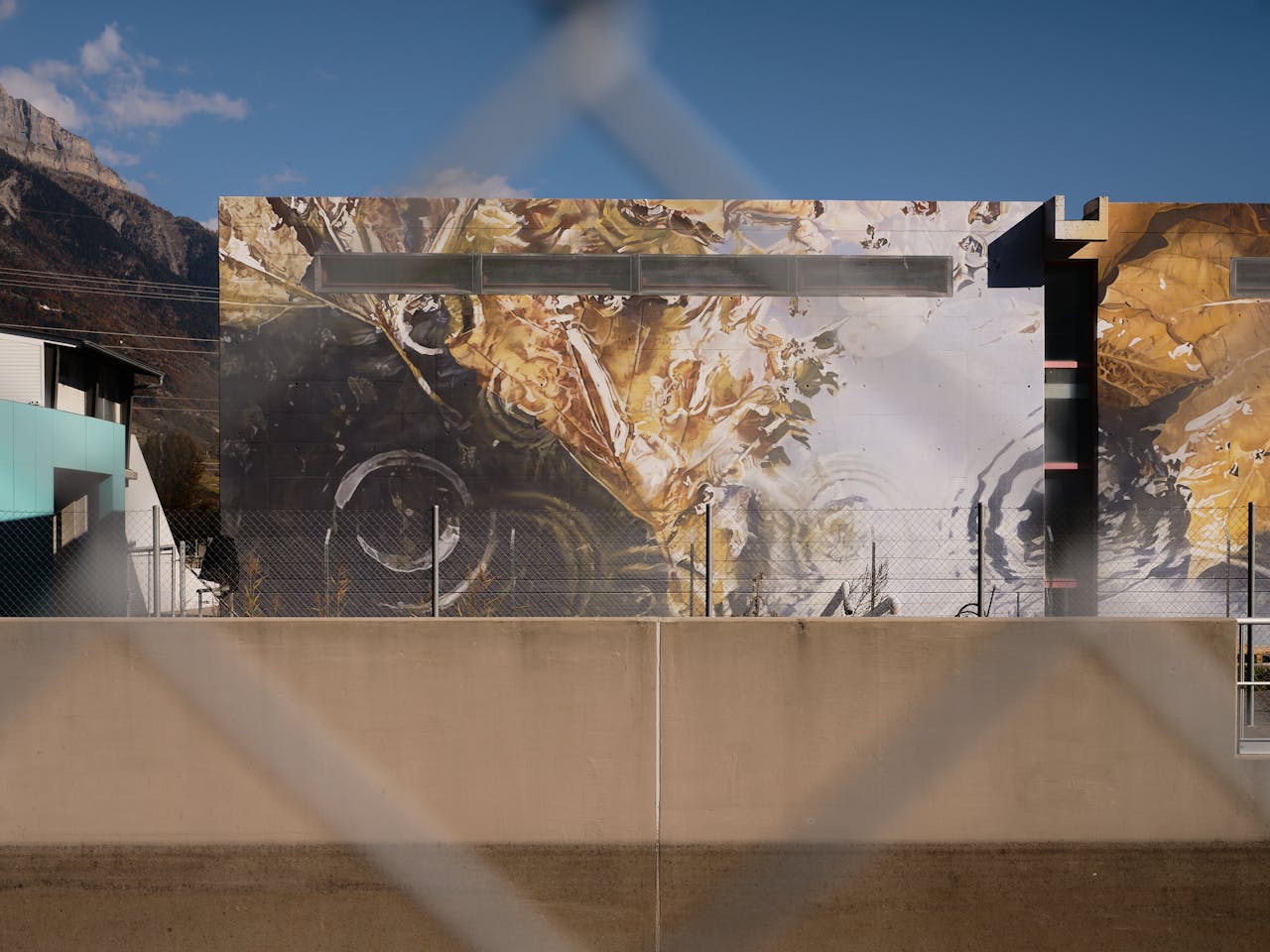
The concept explores a site-specific story relating to the Water...
Monuments Project - Minnesota
Mankato, Minnesota, 2020
Minnesota’s largest mural, this artwork is installed at the Ardent...
Monuments Project - Iowa
Fort Dodge, Iowa, 2018
The largest mural in the state of Iowa, this 360-degree mural on...
The Gods of Dharavi
Mumbai, India, 2017
A collaborative concept with the Slum Gods crew - developed on...
FestiWall
Ragusa, Sicily, Italy, 2017
Commissioned for the 2017 FestiWall public art festival, this...
Coonalpyn
Coonalpyn, South Australia, 2017
Commissioned by Coorong District Council at the Viterra active...
Frontline
Avdeevka, Ukraine, 2016
Painted for Art United Us project in the front line town of...
Mexicable Project, Part I
Ecatepec de Morelos, Mexico , 2016
Part of a series commissioned by Konect1 to launch the Mexicable...
Crystal Ship
Oostende, Belgium, 2016
Painted for the first edition of The Crystal Ship arts festival in...
Brim Silo Project
Brim, Victoria, Australia, 2016
The Brim silo project undertaken by Guido van Helten & Juddy Roller...
Last meal on Halvmåneøya
Svalbard, Norway, 2015
Titled Last meal on Halvmåneøya (Half Moon Island) this work was...
Wall to Wall Festival
Benalla, Victoria, 2015
This work explores the use of old photographs in the modern...
Akureyravaka
Akureyri, Iceland, 2014
'Painted for Akureyrarvaka Menningarnótt (culture night) in 2014...









































